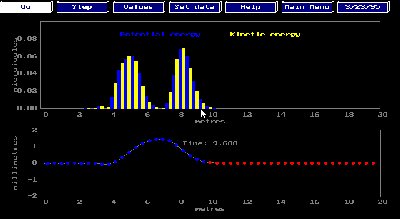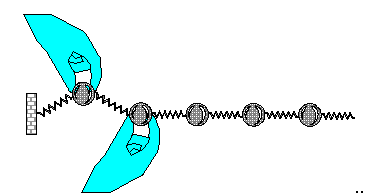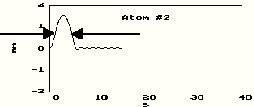


We are looking at the system from above and we will consider the motion of the masses in a horizontal plane. We can therefore ignore gravity -- at least for this tutorial. We will describe the motion of each mass back and forth by a coordinate system like the one labelled "y" on the left of the picture. Note that each mass has its own coordinate to describe its displacement ("yi").
Suppose you hold the second mass in place and pull the first mass to one side as shown in the figure below.

1 . What is the direction of the force exerted on the first mass by the springs? What is the direction of the force exerted on the first mass by your hands?
2. What is the direction of the force exerted on the second mass by the springs alone? What is the direction of the force exerted on the second mass by your hands
? 3. You release both masses at the same instant. Immediately after you release them but before they have a chance to move a significant distance, what is the net force on the first mass? In what direction will it begin to accelerate?
4. When you release the masses, what is the net force on the second mass? In what direction will it begin to accelerate?

In these equations,  means the vector position of the i-th mass,
means the vector position of the i-th mass,  means the vector velocity of the i-th mass, and
means the vector velocity of the i-th mass, and  means the net force on the i-th mass.
The forces are taken to be just the forces due to the springs touching each mass. Notice that the amount of stretch of those springs
and therefore the force on the i-th mass depends on the positions of masses i-1 and i+1 as well as on that of mass i.
means the net force on the i-th mass.
The forces are taken to be just the forces due to the springs touching each mass. Notice that the amount of stretch of those springs
and therefore the force on the i-th mass depends on the positions of masses i-1 and i+1 as well as on that of mass i.
Start the program by typing pulses at the C:> prompt and pressing enter. The program will start with a title screen describing briefly what the program does.
The program calculates and displays the motion of up to 50 masses connected by springs. The masses are all equal to start, but the data entry screen lets you put in different masses to the left and right of the center.
When the program runs its calculation, it moves the first mass quickly up and then back down to its original position once. (The mass is not displaced and "let go" as in our previous discussion.) The rest of the masses simply respond to the forces that they then feel from the springs. The result is a pulse that moves down the chain of masses and springs.
To run this program, you will use the menu bars at the top of the screen. The item highlighted in white is the active item. To change which item is highlighted, use the arrow keys. To activate a highlighted item, press enter. We use the term choose to mean select and activate. To find out in detail what each item does, go to the last page of this tutorial.
1. From looking at the animation, describe in your own words the motion of mass 2.
2. What forces are responsible for this motion? Describe this carefully, including what forces cause it to accelerate and what forces cause it to slow down. Remember! Force produces accelerations, not velocities!
3. Look at the graph of the y-position of mass 2. How does the graph represent the motion you have described?
4. Replay the animation and this time watch mass 20. Describe in your own words its motion. Are the forces that cause this object to change its velocity similar to the ones that caused object 2 to changes its velocity?
1. Notice that both the animation screen and the graphs of the individual mass displacements show a "pulse" -- a curve that starts at zero, rises, and then falls. In your own words, explain the difference in the meaning between these two pulses. Does the fact that one is wide and the other is narrow have any meaning?
Now let's compare the duration of the pulse experienced by each mass. This means we want to measure the width of the pulse as it appears on the position-time graph. Start the animation again by selecting and activating the GO entry on the graph menu. Now let the pulse run past mass 20 on the animation screen so we have a complete pulse displayed in the position-time graph for mass 20.
2. We would like to measure the "width" of the pulse in the position-time graph for the two masses. Explain in your own words the physical meaning of this width.
Notice that the bottom edges of the pulses in the position-time graphs are a bit "ragged". This arises from a variety of reasons, some of which have to do with the limited accuracy of the numerical method used to solve the equations of motion. For this reason, we will use the half-width of the pulse as a measure of its duration. This is the time between when the pulse first reaches half its maximum value on the way up and the time when it reaches that value a second time on its way down. It is the duration between the points where the arrows touch the curve in the figure shown below.

3. Choose VALUES from the graph menu. Use the mouse cursor to get an approximate duration for the pulses displayed in the position-time graphs for the two masses. Note that you really cannot get more than 2 significant figures. To this accuracy do the pulses have approximately the same width?
2. The shape of the "energy pulse" is different from the shape of the displacement of masses along the chain of masses and springs. How many differences can you find?
3. Explain physically why the energy pulse only has positive values.
4. Explain physically why the energy pulse has a zero (or small value) where the pulse of displacements along the chain has a peak. Explain both what is happening with the kinetic and with the potential energies.
If you press enter from the options screen, you will now see the data-entry screen. The parameters of the problem are shown on this screen. The numbers the program is currently using are shown in the black boxes. You can change any of them by typing over the numbers that are there. Use the arrow keys to change your position on the data-entry screen. For now, just look at the numbers. Press enter to accept this data.
Notice that there are now three graph windows. The bottom one displays an animation of the motion of the springs. The top two graphs plot the position of two of the masses. You set which ones in the OPTIONS screen described below.
Also notice that the menu has changed. This is the graph menu. The entries are selected and activated in the same way as those of the main menu, by highlighting them with the arrow keys and pressing enter. The entries do the following things:
Edward F. Redish
Jack M. Wilson
Ian D. Johnston